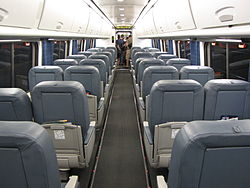BALtoNYPtraveler
Train Attendant
I've read all the literature on what the top speed should be on the NE Regional and the Acela, and I'm not asking for a rehash of that. I'm asking if anyone knows the true figures of what happens in reality.
The reason I ask is that I have a thing on my phone that records speed (someone may tell me that may not be accurate, and that may be true) and I've seen the NE Regional exceed the stated maximum "they say" it's "supposed to" stay within of 125. In fact, today I saw it hit 137.
Is this possible that it's a regular occurrence for that speed to be hit on some stretches? That is never mentioned as a top speed for this train. In fact, that's a smidgen higher than the Acela is supposed to go.
The reason I ask is that I have a thing on my phone that records speed (someone may tell me that may not be accurate, and that may be true) and I've seen the NE Regional exceed the stated maximum "they say" it's "supposed to" stay within of 125. In fact, today I saw it hit 137.
Is this possible that it's a regular occurrence for that speed to be hit on some stretches? That is never mentioned as a top speed for this train. In fact, that's a smidgen higher than the Acela is supposed to go.





